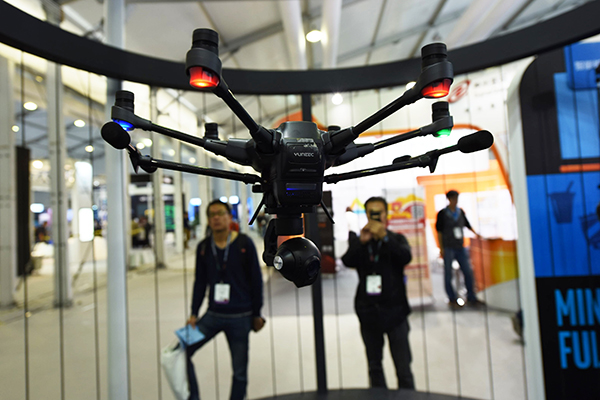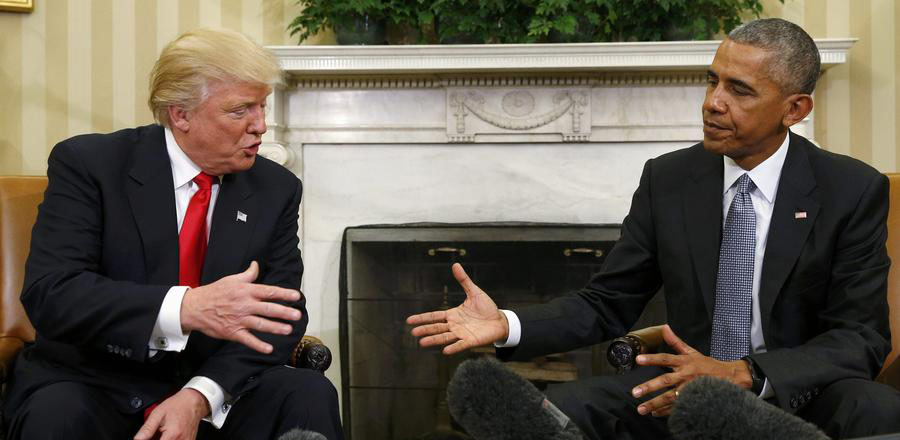
 |
|
Drones on display at an industry expo in Hangzhou,Zhejiang province, Oct 13, 2016. [Photo by Long Wei/Asianewsphoto] |
Latest devices can follow users as they walk, circle subjects
Wei Yilong, a 27-year-old amateur photographer, who set up a video studio, is taking his hobby to new heights and appreciates the compactness of foldable drone for aerial photography.
"The drone can fold up neatly and be carried in a bag, along with my laptop, batteries, smartphone and charger. It is really very easy to carry anywhere compared to the drones I used before."
The drone used by Wei was manufactured by DJI Innovation Technology Co and he has used it in San Francisco.
"I have experienced all the drone range made by DJI, including the Phantom and Inspire series. However, the Mavic Pro has more intelligent functions for shooting, apart from its portability."
The "pocketable" unmanned aerial vehicle, or drone, is no longer a flight of fancy and the concept has taken off from the drawing board and into the skies. Drone manufacturers are stepping up efforts in foldable and intelligent products and this will see the consumer drone market take flight, analysts said.
In the past, quadcopters as they are often called, seemed to be almost exclusively for photography enthusiasts, but with the launch of easy-to-carry and compact drones, ordinary consumers are now able to buy an inexpensive drone for shooting images and their own entertainment.

Seeing tremendous potential in the backpack-sized small drone market, DJI Innovation Technology Co, China's largest commercial drone manufacturer, unveiled a foldable drone, the Mavic Pro, in September.
It is DJI's first drone designed to be taken just about anywhere, weighing just 743 grams, about half of the weight of the company's Phantom 4. Its folding design compresses the entire drone to the size of a water bottle.
Moreover, it contains more high-tech elements. The drone can follow users as they walk around, circle subjects and maintain a constant height. Users can control the drone completely with their gestures and even take a hands-free selfie.
Frank Wang, founder and chief executive officer of DJI, said: "In the past 10 years we were always thinking about how to optimize the operational experience of drones and never stopped updating the products in either their appearance or function. We hope users can tell an aerial photography story in an unprecedented way."
Founded in 2006, the Shenzhen-based DJI currently accounts for 70 percent of the global consumer drone market, according to the company.
Other foreign and domestic drone manufactures are competing fiercely in the burgeoning market and investing more in the compact and foldable drones.
Just about one week before DJI's launch of the Mavic Pro, US action camera manufacturer GoPro Inc released the Karma drone, which also features a compact design and could fit in a small backpack.
GoPro said its Karma drone can run for 20 minutes. The company also announced the Hero5 and the smaller, cube-shaped Hero5 Session.
Chinese internet giant Tencent Holdings Ltd also launched, in October, a 425-gram drone that enables users to upload photos and live streaming videos to WeChat, its instant messaging app, to share with family and friends. It also features WeChat's video-calling function.
The Ying drone is coproduced by Tencent and drone maker ZeroTech Intelligence Technology Co Ltd. Its $299 price tag is competitive especially after considering the fact that DJI Mavic Pro and GoPro Karma are priced relatively higher.
Most consumer drones weigh over 1,000 grams, and need special bags to be taken outside. The lack of portability had become a major problem for drone enthusiasts.
With the rapid growth of portable and entertainment-type drones, at affordable prices, the consumer drone market is predicted to take off.
Industry experts estimate the value of the domestic civilian drone market will reach more than 70 billion yuan ($10.4 billion) by 2025 and the drones for aerial photography and entertainment are expected to account for a 30-billion-yuan market.
"Easy-to-carry and foldable drones represent the future development trend in the consumer drone market. DJI is likely to maintain a dominant position worldwide in technology, marketing and sales channels, compared with its rivals," said Zhao Ziming, an analyst at internet constancy Analysys in Beijing.
DJI has already set up overseas stores in Seoul and Hong Kong and invested heavily in research and development.
"Moreover, the consumer drones tend to be more intelligent, applying visual and voice recognition technology and high definition image transmission technology," said Zhao.
Statistics from Analysys International showed the domestic civil drone market is expected to grow from 3.95 billion yuan this year to 11.09 billion yuan in 2018.
Zhao said the drone which centers on entertainment and social networking functions might attract ordinary people to buy, boosting sales in the low-and-medium sector. Moreover, it may drive more internet companies and startups to enter the competitive drone industry. Last month, a startup named Zero Zero Robotics released its selfie drone, the Hover Camera Passport. Users just use fingers to control the altitude and the horizontal direction while the camera's pitch and drag can be controlled with a single-finger touch.
Jean Xiao, a research manager who tracks drones and wearable products at market research firm IDC, said the foldable and compact drone market may not witness an explosive growth, just yet, due to policy restrictions, including flight duration and altitude.
Xiao said "it is a trend that consumer drones will become more intelligent in the future because the central processing unit of drones is greatly enhanced by major chipmakers Qualcomm Inc, Intel Corporation and Nvidia Corp."
According to a report by IDC, shipments of aerial photography drones reached 40,000 in China during the third quarter of last year. It estimated that shipments will increase to 390,000 units this year and surge to 3 million units by 2019, with the compound growth rate reaching 68 percent in the next five years.
It said competition in the market below the 5,000 yuan entry-level will become fiercer. The number of drone manufacturers will further increase as aerial photography drone solution providers join hands with investors, and internet companies enter the market.
As drone makers face tougher regulations and more competitors, related policies and standards should be further improved, experts said.








